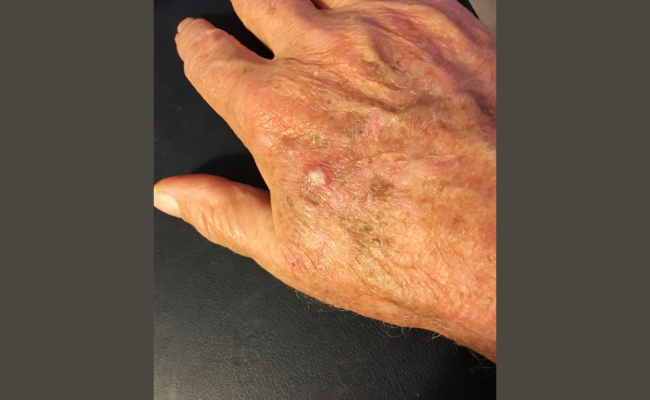How to Treat Bowens Disease?
- December 13, 2023
- No Comments

What is Bowen's Disease?
Bowen's Disease, named after Dr. John T. Bowen, an Australian dermatologist in 1912, is a non-melanoma skin cancer classified as squamous cell carcinoma in situ. Primarily affecting the outermost layer of the skin, it manifests as red, scaly patches. While non-invasive, prompt treatment is essential to prevent its progression into invasive squamous cell carcinoma, posing greater health risks. Medical professionals recognize Bowen's Disease as the initial stage of squamous cell skin cancer, emphasizing the need for timely intervention.
This skin condition bears resemblance to actinic keratosis, a precancerous skin condition with rough, red spots. The key difference lies in the size of the patches, with Bowen's disease patches typically being larger than those associated with actinic keratosis. Differentiating and addressing these conditions promptly is crucial for effective management and minimizing potential health complications.
Why is Bowen's Disease Concerning?
Despite being an early form of skin cancer, Bowen's Disease is a cause for concern due to its potential to advance into a more invasive and aggressive stage if left untreated. The primary risk lies in the transformation of abnormal cells within the epidermis into invasive squamous cell carcinoma, which has the potential to spread to other parts of the body. This progression can result in more complicated treatment procedures and increased health risks. Therefore, timely intervention is crucial to mitigate the risk of complications associated with the advancement of Bowen's Disease.
How Does Bowen's Disease Develop?
The development of Bowen's Disease is often associated with prolonged exposure to ultraviolet (UV) radiation from the sun or artificial sources like tanning beds. UV radiation can induce genetic mutations in skin cells, leading to the formation of cancerous cells. Other risk factors include a history of sunburns, fair skin, older age, and a weakened immune system. Clinically, Bowen's Disease can resemble other skin conditions such as psoriasis or eczema, making accurate diagnosis crucial for effective treatment.
Treatment Solutions for Bowen's Disease
Various treatment options are available for managing Bowen's Disease, and the choice of treatment depends on factors such as the size, location, and extent of the affected area, as well as the overall health of the patient. The goal of treatment is to eliminate the cancerous cells while preserving the function and appearance of the affected skin. Here are some common treatment solutions:
- Imiquimod Cream: This prescription cream stimulates the immune system to target and eliminate abnormal skin cells. It is applied directly to the affected area.
- 5-Fluorouracil (5-FU) Cream: Another topical treatment that interferes with the growth of abnormal cells. It is applied to the skin over a prescribed period.
- Cryotherapy: Liquid nitrogen is used in cryotherapy to freeze and destroy abnormal cells. This method is particularly effective for smaller lesions.
- Curettage and Electrodesiccation: This surgical procedure involves scraping off the cancerous tissue with a curette followed by electrodesiccation, which involves burning the base with an electric current.
- Photodynamic Therapy (PDT): PDT involves applying a light-sensitive medication followed by exposure to a special light, activating the medication and destroying targeted abnormal cells.
- Laser Therapy: Laser therapy uses a focused beam of light to remove or destroy abnormal cells. It is often employed for superficial lesions.
- Surgical Excision: In cases where Bowen's Disease is more extensive or doesn’t respond to other treatments, surgical excision may be recommended. This involves cutting out the cancerous tissue and stitching the wound.
Benefits of Treating Bowen's Disease
- Preventing Progression to Invasive Cancer: Timely treatment significantly reduces the risk of Bowen's Disease progressing into invasive squamous cell carcinoma. This proactive approach is crucial for long-term health and well-being.
- Minimizing Disfigurement: Certain treatment options, such as surgical excision, aim to remove the cancerous tissue while minimizing cosmetic impact. Preserving the appearance of the skin is essential for the overall well-being and confidence of the patient.
- Reducing the Risk of Recurrence: Proper treatment not only eliminates the existing cancerous cells but also significantly lowers the risk of recurrence. This provides patients with peace of mind and the assurance of a lower likelihood of facing the disease again.
- Enhancing Quality of Life: Addressing Bowen's Disease promptly contributes to maintaining a better quality of life for affected individuals. This includes avoiding the physical and emotional burdens associated with more advanced stages of skin cancer.
- Preventing Spread to Other Organs: Early treatment is critical in preventing the spread of cancerous cells to other organs. By containing the disease at its early stage, patients can avoid more extensive treatments and improve their overall prognosis.
Comments (0)